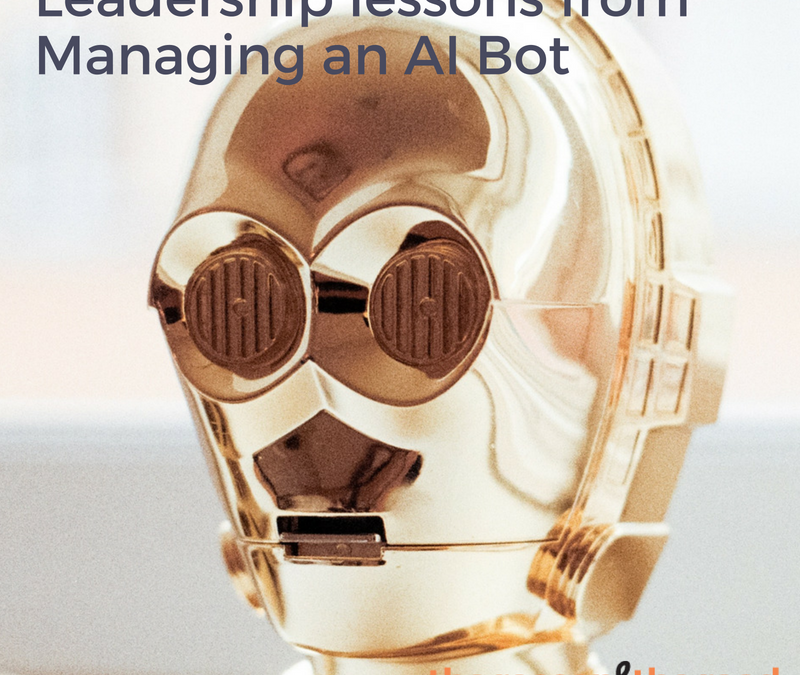
Job Interview Preparation – so you nail it!
June 4, 2018
Are Your Clients High Effort Or High Reward?
August 3, 2018One of the things that leaders are going to have to cope with and manage in the future is the introduction of robotics and artificial intelligence into the workplace.
It’s already being done on a massive scale in manufacturing where specialist functions and processes are being replaced by robotics and it’s also being done in the data analytics space where a lot of startups are using huge computers to crunch data and to give us insights.
One of the spaces where it’s quite new is the area of social robotics where AI robotics is going to increasingly replace human interaction tasks that are currently being done by humans.
I’ve taken my own little foray into this world and what I’m going to share with you my experiences of managing a robot who is interacting with humans and some of the things you as a leader might need to think about in the future when you’re managing robots yourself.
Why did I end up having AI and a robot do something for me?
I’ve talked about it before but fundamentally I believe in terms of you as a leader and your business model, that you should work in your genius.
Literally we should have a circle of things we’re good at and everything outside of that circle we should either automate, delegate or outsource.
If you want to do this for yourself and you want to think of things that you could automate, don’t automate things in your genius, stick at those and then outsource, automate everything else.
The way I do it is every quarter I outsource one non-genius activity and I plan those twelve months ahead then I know what I’m going to outsource and I just do it bit by bit so over time I’m more and more working in that genius zone.
It just happened that Q1 this year I decided “Right, I’m going to focus on outsourcing all my calendar organisation.” I’m going to focus on all the what I call “email ping pong” that I’m sick of. I’m not good at it, it wastes my time, I’d rather be coaching clients and it’s not financially lucrative.
I’ve been watching various technologies over the years, I dabbled with a few and I was really concerned that there was a risk that if you let a robot or a machine interact with your clients that they could damage that relationship. So I was really careful and finally I found this one that I was comfortable with and I’ve spent the last three months working with this robot/AI to work with my clients to put appointments in my calendar.
It’s been generally awesome.
Most clients go “Wow, this is really cool.” and once I explain to them how it works, they’re on board. (As an aside, if anyone wants to see what I use check out x.ai and you’ll get a sense of the tool I’m using).
Basically I copy the AI into an email and say “Could you organise 30 or 60 minutes with this client on this week” and she’ll do all the email ping pong and she’ll put it into my calendar. When I say she, her name is “Amy”. Yes my AI robot has a name.
I want to share with you the four lessons I’ve learnt from managing Amy and my clients – for all of us to get used to working in this robotic world. I think we’re all going to have to take this step at some point, I just happen to have done it in the last quarter.
So here’s the first thing – I think it’s weird if your client is working with a robot and they don’t know it’s a robot or an AI. So I think the first thing is transparency and I always make sure I say to my clients either in email or when I catch up with them: “You she’s a robot right? It’s AI, it’s not a human.” Some of them say “Really?!” because the technology is that good. Machines acting as humans is one of the things socially that we’re going to have to grapple with but I think the right thing to do from a leadership perspective, is to be transparent about that.
The second is – at this stage in development, AI and machine learning doesn’t have as much initiative as we’d like it to. It can’t see two or three tasks ahead. So you have to give it really specific instructions like “Could you please set a calendar invite, 60 minutes, on this date at this time on Zoom” (which is video conferencing tool) and it will do that but if you at all leave a gap in your instruction, it won’t do it for you. There’s probably a general leadership lesson in that – I think at some level it’s allowing us to become better managers because we’re having to manage machines.
The third thing is – most AI tools will have an element of machine learning in them and over time they’ll actually get better at what they do, they’ll learn your preferences and they’ll get better at meeting those needs. I really encourage you to not just accept that the AI tool is doing it the way it is and encourage the machine to learn by giving it feedback. I’m having to say “So my preferences are: I like 45 minutes, or half an hour between my meetings so I can travel” and over time the machine is learning that that’s what I need.
And the fourth one is – its not for all situations and all clients. I know there are some situations where clients will get confused by this, they wouldn’t appreciate it and it wouldn’t add value to their world, so in those situations just don’t use it.
General leadership lessons I’ve had from working with machine learning and AI…
– it’s a great opportunity for use to do what we do well, to work in our genius. I think we all need to consider it and it’s a way of automating things that you’re not good at.
– there is a way to do it systematically and I use the quarterly system.
– as you start to work with machine learning, AI and robots, be really transparent with the clients that this is a machine because I think when it pretends to be human and someone doesn’t know that, that can be really uncool.
– you’re going to have to use really specific instructions. It puts pressure on our ability to delegate tasks effectively and give clear instructions. Pressure, but it’s also an opportunity to improve.
– help the machine learn your preferences
– choose the situations where it’s appropriate.
What does any of this mean to you? The key thing is, work in your genius.
Work on the things that are your strengths, the things you’re good at. The things you were born to do. And then look at AI and robotics to outsource or delegate or automate the other things.
Hope that’s been helpful, look for opportunities to use machine learning in your world and I’ll talk to soon on The Reason & The Road.




